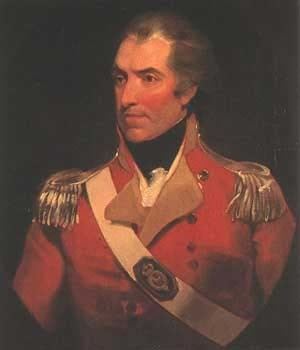Succeeded by George Johnston Preceded by Office Vacant Name William Paterson Service/branch British Army | Allegiance United Kingdom Role Botanist Years of service 1781–1810 Spouse Elizabeth Paterson | |
 | ||
Unit 98th Regiment of Foot73rd Regiment of Foot Books A Narrative of Four Journeys Into the Country of the Hottentots, and Caffraria: In the Years One Thousand Seven Hundred and Seventy-seven, Eight, and Nine | ||
William paterson university corpse flower
Colonel William Paterson, FRS (17 August 1755 – 21 June 1810) was a Scottish soldier, explorer, Lieutenant governor and botanist best known for leading early settlement in Tasmania.
Contents
Early years
A native of Montrose, Scotland, Paterson was interested in botany as a boy and trained in horticulture at Syon in London. Paterson was sent to the Cape Colony by the wealthy and eccentric Countess of Strathmore to collect plants, he arrived in Table Bay on board the "Houghton" in May 1777. He made four trips into the interior between May 1777 and March 1780, when he departed. In 1789 Paterson published Narrative of Four Journeys into the Country of the Hottentots and Caffraria, which he dedicated to Sir Joseph Banks.
Career
Paterson was originally commissioned as an ensign in the 98th Regiment of Foot and served in India. He later transferred to the 73rd Regiment of Foot after the 98th's disbandment in 1787. In 1789, he was promoted to captain in the New South Wales Corps, serving under Major Francis Grose. After some time spent recruiting, he arrived in Sydney in October 1791. From November 1791 until March 1793 he served in command on Norfolk Island. Whilst there he collected botanical, geological and insect specimens and sent them to Banks. He also provided seed to the Lee and Kennedy and Colvill nurseries. He was elected a Fellow of the Royal Society in May 1798.
In 1794 he served for a year as Lieutenant Governor of New South Wales. In 1800 he was re-appointed to the post and served a second term until 1808.
He led an expedition to the Hunter Region in 1801 and up the Paterson River (later named in his honour by Governor King) and in 1804 led an expedition to Port Dalrymple, in what is now Tasmania, exploring the Tamar River and going up the North Esk River farther than European had previously gone.
Between 1804 and 1808 Paterson was also appointed Commandant at Port Dalrymple, the administrator of the colony in the north of Van Diemen's Land. In 1806, Paterson's duties as commander of the New South Wales Corps required him to return to Sydney, but he went back to Van Diemen's Land in 1807, and stayed until December 1808. During this time he corresponded regularly with the eminent naturalist Sir Joseph Banks, sending a number of specimens.
The New South Wales Corps selected Paterson as acting Governor of New South Wales on 1 January 1809 after the deposition of Governor Captain William Bligh in the so-called "Rum Rebellion." He was replaced by the newly arrived Lachlan Macquarie by the end of the year. He left Sydney for England on 12 May 1810, but died on board HMS Dromedary while off Cape Horn just a few weeks later.
His widow Elizabeth married Francis Grose in April 1814, but he died a month later. Elizabeth died in Liverpool, England in 1839.
